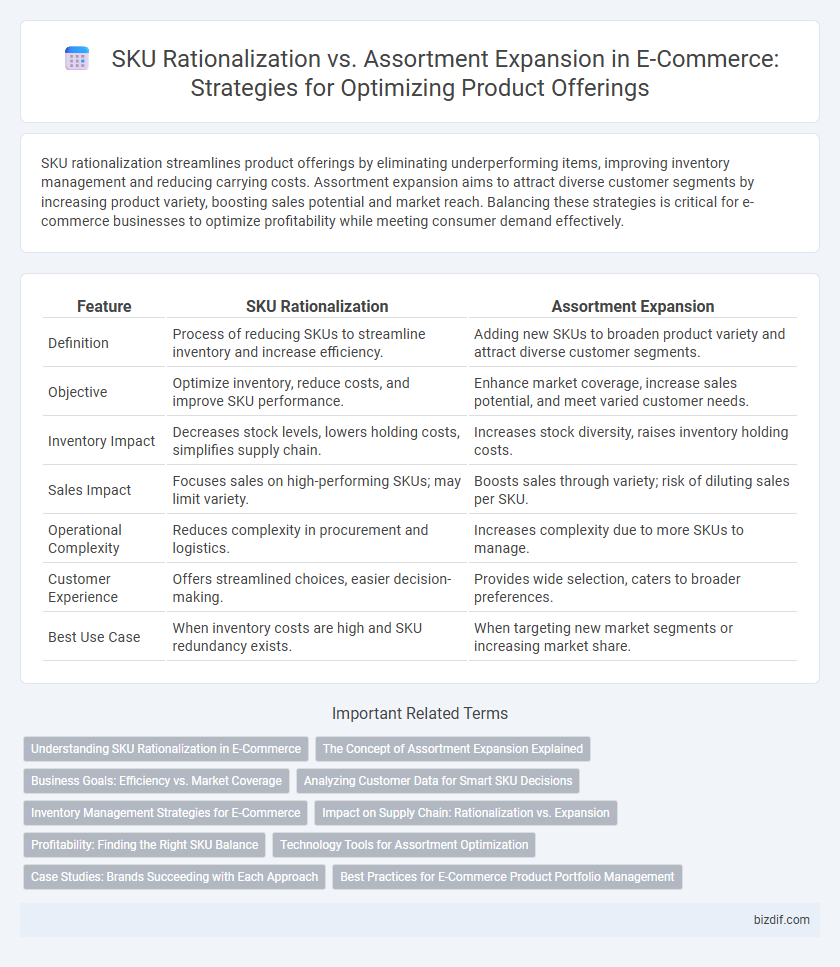SKU rationalization streamlines product offerings by eliminating underperforming items, improving inventory management and reducing carrying costs. Assortment expansion aims to attract diverse customer segments by increasing product variety, boosting sales potential and market reach. Balancing these strategies is critical for e-commerce businesses to optimize profitability while meeting consumer demand effectively.
Table of Comparison
| Feature | SKU Rationalization | Assortment Expansion |
|---|---|---|
| Definition | Process of reducing SKUs to streamline inventory and increase efficiency. | Adding new SKUs to broaden product variety and attract diverse customer segments. |
| Objective | Optimize inventory, reduce costs, and improve SKU performance. | Enhance market coverage, increase sales potential, and meet varied customer needs. |
| Inventory Impact | Decreases stock levels, lowers holding costs, simplifies supply chain. | Increases stock diversity, raises inventory holding costs. |
| Sales Impact | Focuses sales on high-performing SKUs; may limit variety. | Boosts sales through variety; risk of diluting sales per SKU. |
| Operational Complexity | Reduces complexity in procurement and logistics. | Increases complexity due to more SKUs to manage. |
| Customer Experience | Offers streamlined choices, easier decision-making. | Provides wide selection, caters to broader preferences. |
| Best Use Case | When inventory costs are high and SKU redundancy exists. | When targeting new market segments or increasing market share. |
Understanding SKU Rationalization in E-Commerce
SKU rationalization in e-commerce involves analyzing and optimizing the product catalog to eliminate underperforming or redundant stock keeping units, thereby reducing inventory costs and improving operational efficiency. This process relies on data-driven insights from sales performance, customer demand, and profit margins to identify SKUs that contribute little to overall revenue or customer satisfaction. Effective SKU rationalization enhances supply chain management, simplifies inventory control, and enables focused marketing efforts, contrasting with assortment expansion that aims to increase product variety.
The Concept of Assortment Expansion Explained
Assortment expansion in e-commerce involves increasing the variety of products offered to attract a broader customer base and enhance shopping experience, driving higher sales potential. This strategy taps into diverse consumer preferences by introducing new SKUs that complement existing lines, facilitating cross-selling and upselling opportunities. Effective assortment expansion requires data-driven analysis to balance inventory costs with demand, ensuring optimal product mix without overstocking.
Business Goals: Efficiency vs. Market Coverage
SKU rationalization streamlines inventory by eliminating underperforming products to boost operational efficiency and reduce carrying costs, enhancing overall profitability. Assortment expansion aims to increase market coverage by introducing a broader range of products to attract diverse customer segments and capture new revenue streams. Balancing SKU rationalization with assortment expansion is critical for optimizing both efficiency and comprehensive market presence in e-commerce.
Analyzing Customer Data for Smart SKU Decisions
Analyzing customer data enables e-commerce businesses to identify high-performing SKUs and eliminate low-demand products, optimizing inventory through SKU rationalization. Leveraging purchase patterns, browsing behavior, and demographic insights helps tailor assortment expansion to meet evolving customer preferences effectively. Data-driven SKU decisions reduce carrying costs, enhance customer satisfaction, and boost overall profitability by aligning product offerings with market demand.
Inventory Management Strategies for E-Commerce
SKU rationalization optimizes inventory management by reducing excess stock and focusing on high-performing products, which minimizes holding costs and improves turnover rates. Assortment expansion drives customer choice and can increase sales volume but requires advanced demand forecasting and robust inventory tracking to prevent overstock and stockouts. Balancing these strategies enables e-commerce businesses to maintain lean inventories while maximizing product availability and profitability.
Impact on Supply Chain: Rationalization vs. Expansion
SKU rationalization streamlines inventory management by reducing product variety, which lowers holding costs and simplifies demand forecasting, leading to improved supply chain efficiency. Assortment expansion increases product diversity, enhancing customer choice but complicating procurement, inventory control, and order fulfillment, resulting in higher operational costs. Balancing SKU rationalization with strategic assortment expansion optimizes supply chain responsiveness while controlling complexity and expenses.
Profitability: Finding the Right SKU Balance
SKU rationalization improves profitability by eliminating low-performing products that drain resources and storage costs, allowing businesses to focus on high-margin items. Assortment expansion can increase revenue by catering to diverse customer preferences but risks diluting profit margins if new SKUs underperform. Striking the right SKU balance requires data-driven analysis of sales velocity, contribution margin, and inventory turnover to optimize assortments for maximum profitability.
Technology Tools for Assortment Optimization
Technology tools for assortment optimization leverage advanced analytics, machine learning algorithms, and AI-driven demand forecasting to streamline SKU rationalization and support strategic assortment expansion. These tools analyze sales data, customer preferences, and market trends to identify underperforming SKUs and recommend optimal product mixes that maximize revenue and reduce inventory costs. Integration with ERP and inventory management systems ensures real-time decision-making and dynamic adjustments to assortments based on shifting consumer demand and competitive landscape.
Case Studies: Brands Succeeding with Each Approach
Brands like Amazon and Walmart showcase success in SKU rationalization by streamlining inventory to reduce carrying costs and improve turnover rates, resulting in increased profitability and operational efficiency. In contrast, companies like Sephora and Nike excel through assortment expansion, leveraging extensive product variety to enhance customer choice, boost engagement, and capture diverse market segments. Case studies highlight that SKU rationalization benefits brands prioritizing lean operations, while assortment expansion thrives in markets driven by customer experience and personalization.
Best Practices for E-Commerce Product Portfolio Management
SKU rationalization enhances e-commerce efficiency by eliminating underperforming products, reducing inventory costs, and improving customer experience through a streamlined catalog. Assortment expansion drives growth by introducing new, high-demand products to capture diverse customer preferences and increase market share. Effective product portfolio management balances SKU rationalization with targeted assortment expansion using data-driven insights, sales analytics, and customer feedback to optimize profitability and inventory turnover.
SKU Rationalization vs Assortment Expansion Infographic

 bizdif.com
bizdif.com